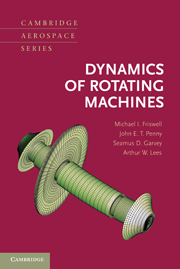Book contents
- Frontmatter
- Contents
- Preface
- Acronyms
- 1 Introduction
- 2 Introduction to Vibration Analysis
- 3 Free Lateral Response of Simple Rotor Models
- 4 Finite Element Modeling
- 5 Free Lateral Response of Complex Systems
- 6 Forced Lateral Response and Critical Speeds
- 7 Asymmetric Rotors and Other Sources of Instability
- 8 Balancing
- 9 Axial and Torsional Vibration
- 10 More Complex Rotordynamic Models
- Solutions to Problems
- Appendix 1 Properties of Solids
- Appendix 2 Stiffness and Mass Coefficients for Certain Beam Systems
- Appendix 3 Torsional Constants for Shaft Sections
- Bibliography
- Index
3 - Free Lateral Response of Simple Rotor Models
Published online by Cambridge University Press: 05 February 2015
- Frontmatter
- Contents
- Preface
- Acronyms
- 1 Introduction
- 2 Introduction to Vibration Analysis
- 3 Free Lateral Response of Simple Rotor Models
- 4 Finite Element Modeling
- 5 Free Lateral Response of Complex Systems
- 6 Forced Lateral Response and Critical Speeds
- 7 Asymmetric Rotors and Other Sources of Instability
- 8 Balancing
- 9 Axial and Torsional Vibration
- 10 More Complex Rotordynamic Models
- Solutions to Problems
- Appendix 1 Properties of Solids
- Appendix 2 Stiffness and Mass Coefficients for Certain Beam Systems
- Appendix 3 Torsional Constants for Shaft Sections
- Bibliography
- Index
Summary
Introduction
In this chapter, we consider the process of creating adequate models of simple rotor systems and examine their lateral vibration in the absence of any applied forces. By “simple,” we mean a rotor system that can be modeled in terms of a small number of degrees of freedom. These simple models consist of either a rigid rotor on flexible bearings and foundation or a flexible rotor on rigid bearings and foundation. Obviously, rotating machines are not designed specifically with these properties; the reality is that rotating machines are designed for a purpose. Shaft dimensions and inertias and the type and dimensions of the bearings are chosen appropriately for the machine function. It may be that the rotor is short with a large diameter, resulting in a shaft that is much stiffer than the bearing and foundations on which it is supported. In such circumstances, it might well be appropriate to model the system as a rigid rotor on flexible bearings and foundations. In these simple models, we assume that both the bearing and foundation can be represented by simple linear springs in the x and y directions. Therefore, the stiffness of the bearing and foundation can be combined and considered as a single entity, using the formula for the stiffness of springs in series, Equation (2.9). Conversely, a machine design might demand a long shaft supported on relatively stiff rolling-element bearings and a stiff foundation. In this case, the bearing and foundation stiffness relative to the shaft stiffness is very high and it may be acceptable to model the system as a flexible rotor on rigid supports. Both models are studied in this chapter.
- Type
- Chapter
- Information
- Dynamics of Rotating Machines , pp. 76 - 123Publisher: Cambridge University PressPrint publication year: 2010

